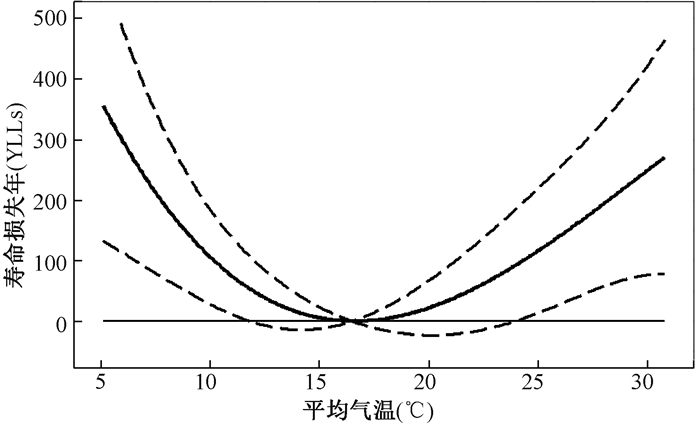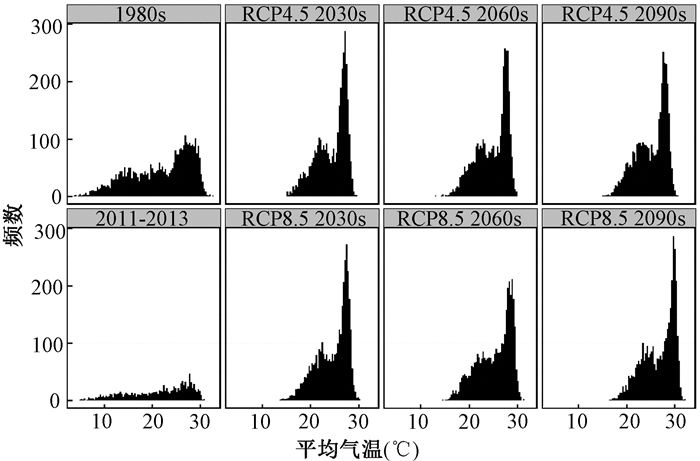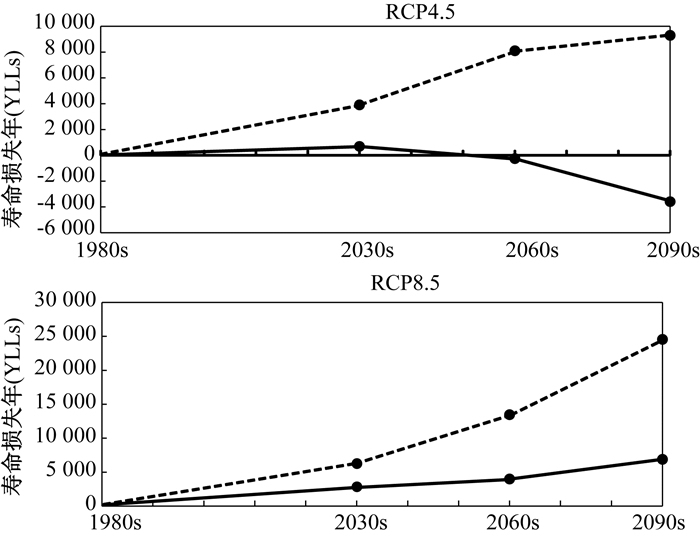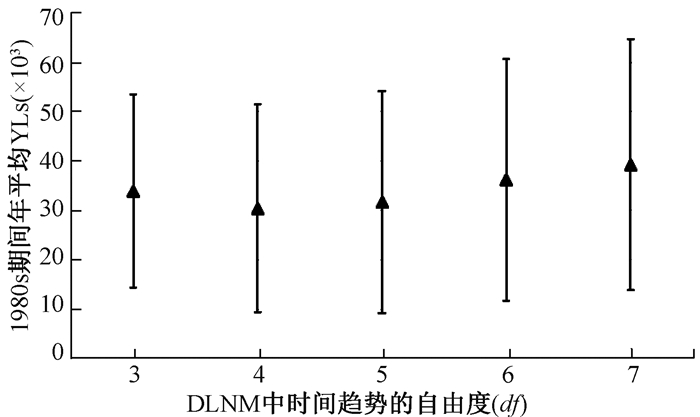2. 广东省气候中心;
3. 广东省疾病预防控制中心慢性非传染性疾病预防控制所
以往大量研究已证实气温升高可通过直接和间接途径增加人群的死亡风险[1-2]。联合国政府间气候变化专门委员会(IPCC)在第五次气候变化评估报告中指出,与1850—1900年相比,本世纪末全球平均气温增幅将超过1.5℃,并且高温热浪等极端气候事件的频率和强度都将增加[3]。然而,目前关于未来气候变化对人群健康风险的研究还比较少,尤其是在发展中国家更少[4-5]。另外,在评估气候变化健康风险时,适应能力是影响其健康效应的重要因素[6-7],然而该因素在以往研究中涉及很少[8-10]。这不利于全球各国制定相应的政策和措施减缓温室气体排放和适应未来的气候变化,因此有必要开展这方面的研究。
城市地区因其人口密度大、热岛效应明显等原因,是气候变化健康影响较为明显的地区[11]。广州市是我国的第三大城市,2016年常住人口数为1 404万,在过去50年中,平均气温每十年上升0.13℃,超过了全国平均水平[12],因此在广州地区开展未来气候变化的健康风险评估具有重要意义。
本次研究拟以广州市为研究点,评估未来不同气候变化情景下,高温引起的人群死亡风险变化趋势,并分析人群适应能力变化对高温死亡风险的影响。研究结果不仅对广州市制定相应的适应气候变化政策具有重要意义,也对全国和全球其他地区具有参考价值。
1 材料与方法 1.1 资料收集广州市2011—2013年期间每日非意外死亡(ICD10:A00-R99)者的信息(死亡地点、年龄、性别等)从广东省疾病预防控制中心获得,根据世界卫生组织(WHO)提供的我国2010年的期望寿命计算每一名死亡者的寿命损失年(Years of Life Lost, YLLs)[13-14],把每一天所有死亡者的YLL相加,获得每日总YLLs。
每日气温(TM)、相对湿度(RH)和平均风速(WS)等气象数据从广东省气象局获得,历史时间段包括19世纪80年代(以下简称:1980s)和2011—2013年,其中1980s为基线时间,未来时间段包括2030s,2060s和2090s。未来的气象数据采用区域气候模式(RegCM4.0)进行预估,由国家气候中心发布,未来温室气体排放情景选择RCP4.5 (Representative Concentration Pathways)和RCP8.5两种[3],分别代表未来低和高两种排放情景[15]。
2011—2013年期间每日空气污染数据从广州市环境监测中心站网站获得,指标包括PM10、NO2和SO2。
由于我国缺乏长时间的气温变化与死亡风险的研究,本次研究采用的适应能力数据来自Petkova等[16]在纽约的研究结果,该研究发现人群对气温的整体适应能力每十年增加约4.6%。
1.2 质量控制以上收集的数据中,死亡数据由当地疾病预防控制中心进行质量控制,所有死亡个体数据均为经过终审的数据,以年均死亡率作为质控指标(>5.0‰);历史气象数据由广东省气候中心进行质量控制,经过审核和矫正后进行发布,未来情景数据由国家气候中心审核和发布;空气污染由广州市环境监测中心审核和发布。
1.3 统计学分析首先采用分布滞后非线性模型(DLNM)分析每日气温与YLLs之间的非线性暴露反应关系,控制的变量包括长期趋势、RH、WS、PM10、SO2、NO2和星期几效应,采用的函数为正态分布函数,模型参数的确定基于AIC的值[17]。根据上述模型得到每一个温度在滞后两天(Lag01)对YLLs的累计效应β及其95%CI,滞后时间的选择根据以往的研究确定[14, 35]。根据效应值β是否具有统计学意义确定高温效应的阈值为23.9℃,即超过23.9℃的温度具有热效应。
随后采用以下方程计算各时间段内(1980s、2030s、2060s和2090s)不同气候变化情景下高温(≥23.9℃)引起的超额死亡风险(YLLs):
| $ YL{L_总} = \sum\limits_{t = 23.9}^n {YL{L_t} \times {N_{TM}}} $ | (1) |
式中:YLL总—总的年均热效应,人年;
YLLt—不同温度对应的热效应,人年;
n—未来时间段内的最高气温值,人年;
NTM—大于23.9℃的每一个气温的频数,人年。
将未来时间段内(2030s、2060s和2090s)的年均YLLs减去基线时间1980s的年均YLLs,即可得到气候变化引起的热效应变化。
在上述结果的基础上,采用下述方程计算适应能力变化对未来热效应的影响:
| $ YL{L_{适应}} = YL{L_总} \times {\left( {1 - 0.046} \right)^n} $ | (2) |
式中:YLL适应—考虑适应能力变化后的热效应,人年;
0.046(4.6%)—热效应每十年的下降率,用于反映居民对气候变化的适应能力[16]。
最后采用敏感性分析检验时间趋势自由度(df)变化对结果的影响。
以上所有分析均采用R 3.4.1进行,所有检验为双侧,P < 0.05为显著性水平。
2 结果 2.1 基本信息广州市1980s期间的平均气温为22.0℃,2011—2013年期间平均气温为21.6℃,每天总人群的平均寿命损失年(YLLs)为2 416.0(表 1)。DLNM的分析结果显示,气温与YLLs之间为“U”型的关系,温度在11.7℃~23.9℃之间对YLLs的影响(lag0-1)没有统计学意义,提示高温引起的死亡风险阈值为23.9℃(图 1)。
| 平均值 | 最小值 | P25 | P75 | 最大值 | |
| 研究期间(2011—2013年) | |||||
| 日均YLLs | 2 416.0 | 1 362.0 | 2 134.0 | 2 652.0 | 3 800.0 |
| 性别 | |||||
| 男性日均YLLs | 1 450.0 | 700.8 | 1 260.0 | 1 631.0 | 2 456.0 |
| 女性日均YLLs | 965.9 | 415.2 | 817.7 | 1 092.0 | 1 833.0 |
| 年龄组 | |||||
| < 65岁 | 1 497.0 | 588.8 | 1 294.0 | 1 685.0 | 2 443.0 |
| ≥65岁 | 919.1 | 382.3 | 779.1 | 1 040.0 | 1 732.0 |
| 日均气温/℃ | 21.6 | 5.1 | 16.6 | 27.0 | 30.8 |
| 日均风俗/(m/s) | 2.5 | 0.8 | 1.7 | 3.1 | 9.5 |
| 相对湿度/% | 78.8 | 30.0 | 72.0 | 87.0 | 100.0 |
| 1980s期间的平均气温/℃ | 22.0 | 3.9 | 16.8 | 27.3 | 32.7 |
| SO2 /(μg/m3) | 22.7 | 2.0 | 15.0 | 28.8 | 91.0 |
| NO2 /(μg/m3) | 45.5 | 9.8 | 29.2 | 55.9 | 162.6 |
| PM10 /(μg/m3) | 69.7 | 9.6 | 43.2 | 88.6 | 180.75 |
| 未来日均气温(℃) | |||||
| RCP4.5 | |||||
| 2030s | 24.5 | 15.2 | 22.1 | 27.1 | 29.6 |
| 2040s | 24.6 | 14.1 | 22.1 | 27.5 | 29.5 |
| 2060s | 25.0 | 13.2 | 22.5 | 27.8 | 30.0 |
| 2090s | 25.1 | 15.0 | 22.7 | 27.8 | 30.5 |
| RCP8.5 | |||||
| 2030s | 24.7 | 13.9 | 22.3 | 27.4 | 30.2 |
| 2040s | 24.9 | 13.8 | 22.5 | 27.6 | 29.8 |
| 2060s | 25.5 | 14.6 | 22.8 | 28.5 | 31.4 |
| 2090s | 26.7 | 16.5 | 24.1 | 29.6 | 32.2 |

|
| 图 1 广州市2011—2013年期间日均气温与寿命损失年(YLLs)之间的关系 |
2.2 未来气候变化趋势
未来气候预估结果显示,与1980s年代相比RCP4.5和8.5情景下未来气温均呈上升趋势,2030s年代气温分别上升2.5℃和2.7℃,2090s年代分别上升3.1℃和4.7℃(图 2)。

|
| 图 2 广州市未来不同时间内日均气温的分布 |
2.3 未来气候变化对YLLs的影响
在RCP4.5和8.5情景下,与1980s年代相比,未来高温引起的YLLs均呈上升趋势。在RCP4.5情景下,2030s,2060s和2090s期间温度上升引起的年平均YLLs比1980s分别增加了3 903.7, 8 094.8和9 285.0(假设人口和适应能力不变)。而在RCP8.5情景下,2030s,2060s和2090s期间温度上升引起的年平均YLLs比1980s分别增加了6 258.5,13 459.6和24 549.0(图 3)。

|
| 注:虚线表示未考虑居民适应能力时的热效应;实线表示考虑了居民适应能力后的热效应。1980s为基线水平 图 3 广州市未来气候变化引起的热效应(YLLs) |
适应能力增加可大幅降低气候变化引起的YLLs,例如在RCP8.5情景下,适应能力可分别使2030s、2060s和2090s期间的热效应降低54%、70%和72%。另外,在RCP4.5情景下,适应能力增加可完全抵消气候变化引起的热效应(图 3)。
2.4 敏感性分析经敏感性分析发现,DLNM模型时间趋势自由度的改变对1980s年代YLLs的影响较小(图 4)。

|
| 图 4 广州市1980s期间热效应引起的年平均YLLs |
3 讨论
IPCC第五次报告认为在未来一段时间内全球气候变化是不可避免的,全面评估气候变化的健康影响具有重要的公共卫生学意义[3, 18]。本次研究以广州市为例,评估了不同未来气候变化情境下高温对居民死亡风险的影响,发现居民的死亡风险(YLLs)在RCP4.5和RCP8.5情境下明显升高,然而居民适应能力的提升可大幅降低未来气候变化造成的健康风险。
在我国其他地区开展的研究也支持我们的发现[19-21],例如李湉湉等[20]在北京的研究发现,与1980s年对比,在RCP8.5情境下北京居民在2020s、2050s和2080s期间发生心血管疾病死亡的风险分别增加16.6%,73.8%和134.0%。Li等[22]在天津的研究也发现,未来气温增加均可大幅增加居民的死亡风险,若气温升高2℃,2055年该市每年可造成6143YLLs的超额疾病负担。这些结果表明未来气候变化可造成严重的居民死亡风险,必须及早制定和实施相关的减排和适应政策,以降低未来的健康风险。
本研究进一步发现,居民的适应能力增加可大幅降低未来气候变化引起的死亡风险,甚至在RCP4.5情景下,适应能力增加可完全抵消气候变化引起的热效应,提示适应的重要性。在其他国家开展的研究也支持我们的结果,例如Jenkins等[23]在伦敦的研究发现,2050s期间居民的适应能力每提升1℃可降低热效应32%~42%。Zhang等[24]在北京的研究也证实,居民对气候变化适应能力的提升可大幅降低未来气候变化引起的心血管疾病死亡风险。人类已经向大气环境排放了大量的温室气体,即使现在就实施严格的减排措施,也不能在短时间内扭转气候变暖的趋势,因此如何提高居民的适应能力是目前降低气候变化健康影响的关键措施[7, 25],例如建立区域性的气象早期预警和应对系统,通过健康教育提高居民对气候变化的认知水平和采取应对措施的能力,针对老年人等建立纳凉中心等[18]。
本研究采用了寿命损失年(YLLs)用于反映居民的超额死亡风险,具有一定的先进性。以往大多数研究采用死亡数或者死亡率作为风险指标,这些指标赋予不同年龄的死亡者相同的权重,而不同年龄的死亡造成的疾病负担差别很大,因此这些结果可能存在一定的偏倚[9]。而YLLs通过期望寿命赋予年轻死亡者更高的权重[13, 26],因此可为政策制定提供更为全面的信息[13]。近年来,YLLs逐渐得到学术界的重视,例如Huang等[9]首次采用此指标评估了澳大利亚布里斯班市未来气候变化对居民死亡风险的影响,Guo等[27]采用YLLs评估了北京市空气污染引起的居民超额死亡风险。
本研究也存在一些局限性,首先本研究仅仅采用了区域气候模型数据,未纳入全球气候模式数据,这对分析未来气候变化的不确定性具有一定的局限性,以往研究已经证实未来气候变化的健康风险在不同气候模型之间差别较大[6, 28]。其次,本次研究未考虑未来人口的变化,而人口及其年龄结构的变化对未来气候变化健康影响具有重要的修饰效应,尤其在计划生育等政策的影响下其影响更为明显。最后为气温与YLLs暴露反应关系,本研究假设二者的关系在未来保持不变,而实际上随着人群适应能力的提高,二者的关系可能会发生明显的变化,从而影响未来气候变化的热效应[29]。因此,今后的研究应充分考虑上述因素,更加全面的评估未来气候变化对健康的影响,为适应政策制定提供更为全面的科学信息。
| [1] |
Kolb S, Radon K, Valois MF, et al. The short-term influence of weather on daily mortality in congestive heart failure[J]. Arch Environ Occup Health, 2007, 62(4): 169-176. DOI:10.3200/AEOH.62.4.169-176 |
| [2] |
Matthies F, Bickler G, Marín NC, et al. Heat-health action plans: guidance[R]. Copenhagen: WHO Regional Office for Europe, 2008.
|
| [3] |
Stocker TF, Qin D, Plattner GK, et al. Climate Change 2013: The Physical Science Basis. Contribution of Working Group I to the Fifth Assessment Report of the Intergovernmental Panel on Climate Change[M]. Cambridge, United Kingdom, New York, NY, USA: Cambridge University Press, 2013.
|
| [4] |
Huang CR, Barnett AG, Wang XM, et al. Projecting future heat-related mortality under climate change scenarios:a systematic review[J]. Environ Health Perspect, 2011, 119(12): 1681-1690. DOI:10.1289/ehp.1103456 |
| [5] |
Gosling SN, Lowe JA, McGregor GR, et al. Associations between elevated atmospheric temperature and human mortality:a critical review of the literature[J]. Clim Change, 2009, 92(3-4): 299-341. DOI:10.1007/s10584-008-9441-x |
| [6] |
Li TT, Horton RM, Kinney PL. Projections of seasonal patterns in temperature-related deaths for Manhattan, New York[J]. Nat Climate Change, 2013, 3(8): 717-721. DOI:10.1038/nclimate1902 |
| [7] |
Vardoulakis S, Dear K, Hajat S, et al. Comparative assessment of the effects of climate change on heat-and cold-related mortality in the United kingdom and australia[J]. Environ Health Perspect, 2014, 122(12): 1285-1292. DOI:10.1289/ehp.1307524 |
| [8] |
Peng RD, Bobb JF, Tebaldi C, et al. Toward a quantitative estimate of future heat wave mortality under global climate change[J]. Environ Health Perspect, 2011, 119(5): 701-706. DOI:10.1289/ehp.1002430 |
| [9] |
Huang CR, Barnett AG, Wang XM, et al. The impact of temperature on years of life lost in Brisbane, Australia[J]. Nat Climate Change, 2012, 2(4): 265-270. DOI:10.1038/nclimate1369 |
| [10] |
Hales S, Kovats S, Lloyd S, et al. Quantitative risk assessment of the effects of climate change on selected causes of death, 2030s and 2050s[J]. World Health Organization, 2014, 17-26. |
| [11] |
林琳, 马飞. 广州市人口老龄化的空间分布及趋势[J]. 地理研究, 2007, 26(5): 1043-1054. (In English: Lin L, Ma F. Spatial distribution and trends of the aging of population in Guangzhou[J]. Geogr Res, 2007, 26(5): 1043-1054. DOI:10.3321/j.issn:1000-0585.2007.05.021) |
| [12] |
林培松. 广州市近50年来气候变化分析[J]. 聊城大学学报(自然科学版), 2007, 20(3): 81-84. (In English: Lin PS. Analysis on the climate characteristic and climatic change in Guangzhou city in last 50 years[J]. J Liaocheng Univ (Nat Sci), 2007, 20(3): 81-84. DOI:10.3969/j.issn.1672-6634.2007.03.023) |
| [13] |
Steenland K, Armstrong B. An overview of methods for calculating the burden of disease due to specific risk factors[J]. Epidemiology, 2006, 17(5): 512-519. DOI:10.1097/01.ede.0000229155.05644.43 |
| [14] |
Global Health Observatory Data Repository. Browse data tables by topic[EB/OL]. (2013-06-21).[2016-12-18].World Health Organization. http://apps.who.int/gho/data/?theme=main&vid=60340.2013.
|
| [15] |
van Vuuren DP, Edmonds J, Kainuma M, et al. The representative concentration pathways:an overview[J]. Clim Change, 2011, 109(1-2): 5-31. DOI:10.1007/s10584-011-0148-z |
| [16] |
Petkova EP, Gasparrini A, Kinney PL. Heat and mortality in New York City since the beginning of the 20th century[J]. Epidemiology, 2014, 25(4): 554-560. DOI:10.1097/EDE.0000000000000123 |
| [17] |
Peng RD, Dominici F, Louis TA. Model choice in time series studies of air pollution and mortality[J]. J Roy Stat Soc Ser A Stat Soc, 2006, 169(2): 179-203. DOI:10.1111/rssa.2006.169.issue-2 |
| [18] |
Field CB, Barros VR, Dokken DJ, et al. Climate Change 2014: Impacts, Adaptation, and Vulnerability. Part A: Global and Sectoral Aspects. Contribution of Working Group Ⅱ to the Fifth Assessment Report of the Intergovernmental Panel on Climate Change[M]. Cambridge, United Kingdom and New York, NY, USA: Cambridge University Press, 2014.
|
| [19] |
Zhang J, Li TT, Tan JG, et al. Impact of temperature on mortality in three major Chinese cities[J]. Biomed Environ Sci, 2014, 27(7): 485-494. |
| [20] |
Li TT, Ban J, Horton RM, et al. Heat-related mortality projections for cardiovascular and respiratory disease under the changing climate in Beijing, China[J]. Sci Rep, 2015, 5: 11441. DOI:10.1038/srep11441 |
| [21] |
Li TT, Horton RM, Bader DA, et al. Aging will amplify the heat-related mortality risk under a changing climate:projection for the elderly in Beijing, China[J]. Sci Rep, 2016, 6: 28161. DOI:10.1038/srep28161 |
| [22] |
Li YX, Li GX, Zeng Q, et al. Projecting temperature-related years of life lost under different climate change scenarios in one temperate megacity, China[J]. Environ Pollut, 2018, 233: 1068-1075. DOI:10.1016/j.envpol.2017.10.008 |
| [23] |
Jenkins K, Hall J, Glenis V, et al. Probabilistic spatial risk assessment of heat impacts and adaptations for London[J]. Clim Change, 2014, 124(1-2): 105-117. DOI:10.1007/s10584-014-1105-4 |
| [24] |
Zhang BY, Li GX, Ma Y, et al. Projection of temperature-related mortality due to cardiovascular disease in beijing under different climate change, population, and adaptation scenarios[J]. Environ Res, 2018, 162: 152-159. DOI:10.1016/j.envres.2017.12.027 |
| [25] |
Hajat S, O'Connor M, Kosatsky T. Health effects of hot weather:from awareness of risk factors to effective health protection[J]. Lancet, 2010, 375(9717): 856-863. DOI:10.1016/S0140-6736(09)61711-6 |
| [26] |
Lopez AD, Mathers CD, Ezzati M, et al. Global Burden of Disease and Risk Factors[M]. New York, USA: Oxford University Press, 2006.
|
| [27] |
Guo YM, Li SS, Tian ZX, et al. The burden of air pollution on years of life lost in Beijing, China, 2004-08:retrospective regression analysis of daily deaths[J]. BMJ, 2014, 347: f7139. |
| [28] |
Petkova EP, Bader DA, Anderson GB, et al. Heat-related mortality in a warming climate:projections for 12 U.S. cities[J]. Int J Environ Res Public Heal, 2014, 11(11): 11371-11383. DOI:10.3390/ijerph111111371 |
| [29] |
Martin SL, Cakmak S, Hebbern CA, et al. Climate change and future temperature-related mortality in 15 Canadian cities[J]. Int J Biometeorol, 2012, 56(4): 605-619. DOI:10.1007/s00484-011-0449-y |



